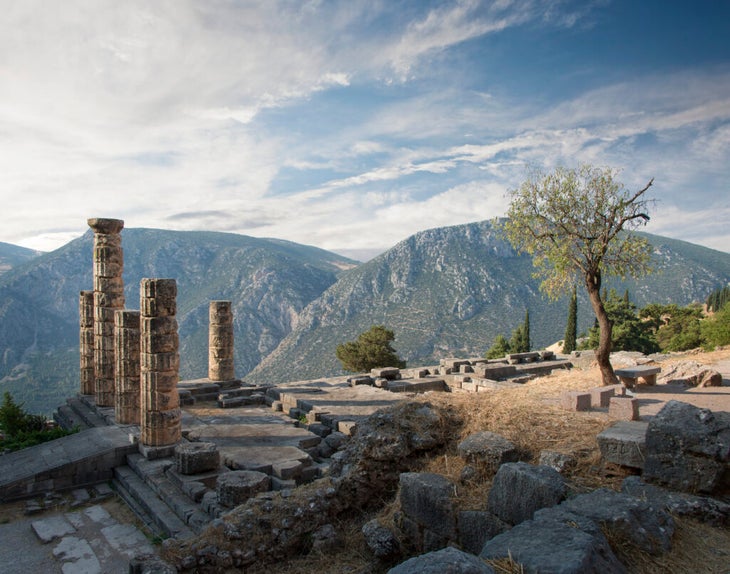News
What We Can Learn About Endurance Fuel From Ancient Greece
Published
2 years agoon
By
Robert King
“], “filter”: { “nextExceptions”: “img, blockquote, div”, “nextContainsExceptions”: “img, blockquote”} }”>
Training and fueling cycles can become tedious or monotonous for even the most ambitious trail runners. At a point, everyone needs a little something different to try and spice things up, whether you’re talking about a romantic relationship or someone who likes to spend their free time running long miles on the trails.
That “spice” can be any number of things. For some runners, myself included, re-establishing a connection to the fundamentals can be game-changing. One of those fundamentals is fueling.
But how can we make fueling interesting again?
Pre-packaged sports nutrition and gels have by and large taken over the fueling market in trail running. Sure, sports gels are a miraculous and convenient hit of measured nectar, nearly perfect for when your body’s unable to metabolize a larger meal or snack. But how many runners actually look forward to sucking down that goop? What if, instead, you could fuel with something that connects you to history, to a story?
With that in mind, I became interested in exploring the diets of endurance athletes throughout human history, from cultures across the world. Perhaps by putting ourselves in the shoes of ancient legends, or simply connecting to our own culinary heritage, this sometimes overlooked aspect of the sport can become exciting.
For starters, we go back to where much of the Western World’s concept of competition began––ancient Greece.
The Diet of Ancient Greek Athletes
Few bodies are as unrealistically chiseled as those that come to mind when imagining the athletes of ancient Greece. Think of Discobolos of Myron, the ancient Greek sculpture depicting a young male athlete throwing a discus. The definition makes 4K resolution seem out of focus.
This representation of ancient Greek bodies persists into contemporary art and cinema. After all, who could forget King Leonidas’ forces from the 2006 film 300––equipped with spears, capes, and a rock-hard six pack.
The truth is, sources from that time period who reported on the physique and training regimens of ancient Greek athletes are limited. Whereas these days, you can find differing experts who will praise one nutrient while the other warns of its connection to cancer or some other terrifying illness.
To get the best information available, I reached out to Dr. Manfred Lämmer from the German Sport University Cologne––a sports historian and sports scientist who’s studied the diet of ancient Greek athletes. According to Dr. Lämmer, diets varied depending on the sport––much like in modern athletics.
“For example, goat meat was said to be particularly good for jumpers and runners, bull meat for boxers and throwers, and fatty pork for wrestlers––probably on account of their prime goal of putting on weight,” wrote Dr. Lämmer in an academic paper titled “Nutrition in ancient Greek Athletics.”
That said, the emphasis of the ancient Greek diet focused on simple foods. Lämmer’s writing concurs with the general consensus from ancient authors that athletes generally ate bread made of ancient grains, like barley, fresh cheese, and figs. These were believed to strengthen both the body and mind.
RELATED: How To Fuel With Purpose
What Would Zeus Do?
The ancient Greeks also had a different understanding of how success was determined. As Lämmer put it, it was the Gods who decided between victory and defeat. We humans were merely mortal playthings in their own dramas and personal feuds. Homer (the writer, not the simpleton of Springfield) illustrated this by describing the prayers recited before an event or the sacrifices promised to the Gods should things go their way.
“These were meant to enhance their own performance and served as mental stimulation,” writes Lämmer.
In another example, a collection of papyruses contains the magic spell that was to be inscribed onto the nails of the two large toes with an iron stylus, in order to secure speed and stamina for the runner as well as the public’s favor. I imagine it was a more elaborate version of the dirty lucky socks or running shorts––just a smidge more sanitary.
In lieu of incorporating ancient incantations into your pre-run and active fueling routines, I contacted Claire Shorenstein (MS RD CSSD CDN), a board-certified sports dietitian who focuses on endurance performance, to find out how trail runners can incorporate the flavors of ancient Greece into their diet. After all, it doesn’t hurt to steal some of that Spartan intensity when climbing up your third 2,000-vertical-foot ascent of the race.

Fresh Cheese
Shorenstein said that cheese most likely wouldn’t play a major role in fueling runs. During exercise, we want to focus mostly on consuming carbs rather than the fat and protein you’d find in cheese.
“That said, in endurance events, and especially in trail running where the pace is generally slower and the event times are longer, cheese could play a role of some kind,” she said. “For example, we do see some runners eating cheese quesadillas and other products with cheese in much longer events. Because in those situations, we do need fat and protein. It’s just a question of which types of foods you can tolerate.”
Ultimately, Shorenstein scores fresh cheeses––like ricotta, mozzarella, creamy goat cheese, and a crumbly feta––with a question mark for use during a run. That said, something like a little feta in a rice ball for flavor and salt could work out.
Figs and Barley
Figs and barley are both high in carbohydrates and rich in fiber. There’s also some iron in figs, which is a nutrient that Shorenstein keeps an eye on with endurance athletes.
“We of course need carbs. Anywhere between 30 to 90 grams per hour of exercise depending on how long you’re running for,” she said. “So these foods are great in that sense.”
The fiber, however, might be problematic. It’s great for everyday fueling, says Shorenstein, but things would likely get tricky during exercise, especially if running at higher intensities.
“It’s one thing to have a single snack with fiber during a run, such as a small handful of dried figs as part of your general fueling plan, and it’s another thing to have fiber-rich snacks make up the bulk of your fueling,” she says. “Figs are pretty caloric, especially when dried. But in order to get the amount of calories and carbs that you need to adequately fuel exercise, you’d have to consume quite a lot and that would likely cause GI distress. Even a small amount of figs may cause issues for runners with sensitive stomachs. There’s a reason things like dried figs and prunes are recommended for constipation!”
Fueling like an Ancient Greek Athlete
If you wish to give these foods a try, Shorenstein recommends starting by adding them in small amounts to the foods that you already know work well for you.
“Dried figs would be fantastic to snack on, just like I do personally with dates, before, during or after a run,” adds Shorenstein. “Or if your favorite pre-run meal is toast or oatmeal with nut butter and banana, you could add some dried fig slices to boost the carb count. Either way, I would portion control the figs. Start with one or two.”
There’s the obligatory caveat that every human body is different and will react differently to these foods. What you tolerate also will depend on how much time you have between eating and heading out for your run, says Shorenstein. More time means you likely can tolerate a larger, more balanced meal that contains some fiber as you will have time to digest and use the bathroom, but this takes practice.
RELATED: No, You Don’t Really Need Those Pricey Sports Gels. Fuel Your Runs With These 4 Natural Foods
As for during a run, Shorenstein explains that exercise causes more blood to be shunted away from the gut and to the working muscles, especially when working at higher intensities, which is why it can be harder to digest solid food.
Shorenstein recommends taking plenty of time to train your gut to tolerate the different foods and sports nutrition products you plan to use. Choose mostly foods that are lower in fiber, fat, and protein and rich in easy-to-digest carbs. For longer endurance events, where you will be missing more than one traditional mealtime, practice incorporating carb-rich foods that also contain protein and fat (PB&J, protein bar, chicken noodle soup, for example).
So an ancient Greek barley porridge or barley bread with almond butter and dried figs or fig jam would be great for pre-run fueling. You could add a little bit of feta cheese (Shorenstein recommends a very light sprinkle, perhaps a spoonful) for flavor, salt, and an extra bit of protein.
During a run, you could nosh on a fig newton bar with a crust made from barley flour. This will give you a solid dose of carbohydrates to support your hard-working muscles, while filling you up more than your traditional gel or sports drink.
Another important thing to remember is that your body has different requirements before and after exercise.
“Before exercise, we’re mostly focused on easy-to-digest carbs with a small amount of protein––approximately 8 to 10 grams. The guideline we often use is 1 to 4 grams of carbs per kilogram of bodyweight taken 1 to 4 hours prior to the workout,” explains Shorenstein. “Afterwards, we’re going for a balanced meal with carbs, fats, and protein (if you want to calculate your own protein needs post-run, the guideline is 0.3-0.5 grams of protein per kg of bodyweight). You can certainly include fresh cheese and barley, which both contain protein, but ideally we’d have another protein source as well to reach your protein goals (e.g. beans, legumes, fish, meat, soy etc.).”
Below we’ve outlined what your pre-run and race/training fueling can look like using the diet of ancient Greek athletes for inspiration.
PRE-RUN MEAL
Pearl barley porridge with feta cheese
- 1 cup or about 200 grams of pearl barley
- 1.5 liter water
- 1 cup almond milk
- 1 teaspoon cinnamon
- ¼ teaspoon nutmeg
- 1 tablespoon feta cheese
- Honey or date syrup to taste
- ½ cup walnuts
- ¼ cup dried figs
Optional: Have a slice of barley bread with almond butter and dried figs or fig jam
Instructions
-
- Place the pearl barley in a fine mesh strainer and rinse under cold water.
- Follow package instructions for cooking the pearl barely or boil water in a medium-sized pot and add pearl barley. Lower heat to a simmer and cover for approximately 25 minutes. Stir occasionally to avoid the pearl barley sticking to the bottom of the pot.
- Once the pearl barley is al dente, drain using a fine mesh strainer and rinse under cold water. Return the pearl barley to the medium-sized pot and add half of the almond milk. Bring it back to a boil at medium to medium-high heat, stirring frequently to avoid burning and sticking to the pot––like a risotto.
- Season with cinnamon and nutmeg and continue stirring until everything is blended.
- After a few minutes, add the second half of the almond milk. Continue mixing until you get a creamy, not wet, consistency. Then remove the pot from the heat and grate the feta directly into the pearl barley and mix.
- Serve with a few scoops of the pearl barley at the bottom of the bowl, top with roughly chopped walnuts, dried figs, cinnamon, and additional grated feta cheese to taste. Add honey or date syrup to taste and mix.
- Optional: Serve with a little peanut or almond butter on a scoop of non-fat Greek yogurt for extra protein.
ENERGY BAR RECIPE
Barley fig newton
- Fig filling
- 8 ounces of dried figs, stemmed and quartered
- 2 cups of water
- 1 tablespoon honey or date syrup
- ¼ teaspoon kosher salt
- 2 teaspoons of lemon juice
- Crust
- 1 to 1 ¼ cups barley flour
- ½ teaspoon baking powder
- ¼ teaspoon kosher salt
- 6 tablespoons butter
- ¾ cup packed brown sugar
- 1 large egg
- 1 teaspoon vanilla extract
Instructions
Fig filling:
- Fill a small stovetop pot with water and add dried figs. Simmer for about 30 minutes until soft.
- Add to a food processor with honey or date syrup, kosher salt, and lemon juice. Blend until well mixed. (It should look like marmalade.)
Crust
- Mix flour with baking powder and kosher salt in a medium-sized bowl.
- In a large bowl, blend room-temperature butter with brown sugar until creamy in a stand mixer. Add egg, vanilla extract, and continue blending until well incorporated.
- Slowly add dry ingredients to your wet ingredients until a dough is formed. Remove the dough from the bowl and gently knead into a flat disc. Wrap in cling wrap and place in the refrigerator for about 1 hour.
Assembly
- Preheat the oven to 350F.
- Line an 8×8 baking dish with parchment paper and spray with non-stick cooking spray or lightly brush with butter or olive oil.
- Reserve about ¾ cup of the dough for topping at the end. Add the rest to your baking dish and press it down so it covers the bottom of the baking dish. Place in the oven for about 20 minutes.
- Meantime, flatten or roll out the remaining dough in the shape of a square on parchment paper and place in the freezer.
- After about 20 minutes, remove the baking dish from the oven. Add the fig filling on top and spread evenly.
- Remove the remaining dough from the freezer and cover the top of the baking dish with the dough. Note: Don’t worry if the dough rips or cracks. Just cover the top of the baking dish with the dough and gently press around the edges.
- Place in the oven for about 25 – 30 minutes or until the crust is golden brown.
- Set on a wire rack and let cool for at least one hour before cutting and serving.
Recent News


4 Amazing Trips for Your Family
Choosing somewhere for a family vacation that would pique the attention of adults and kids alike can be a fun...


Customising Your Makeup with Blendable Blush Options
In cosmetics, one’s face is a canvas for self-expression and creativity. Among the myriad of products available, blush is a...


The Benefits of Regular Home Maintenance
Regular home maintenance is essential for maintaining and even raising the value of your house. A proactive approach to repairs...


Understanding the Importance of SEO in Adelaide
In the digital marketplace, Adelaide businesses are in a continuous contest to gain the attention of their target audiences. With...


Breaking Down the Numbers: Understanding the Average Traveling Nurses Pay
The open road, adventure, and the chance to heal – travel nursing promises an undeniable allure. But amidst the excitement,...


Dealing with Oily Skin in Summer: Tips and Tricks
As the temperature rises, those with oily skin often face an additional challenge—maintaining a clear and balanced complexion. Excess oil...


Mountain Wedding Ideas for 2024
A mountain wedding is a stunning choice for couples who cherish nature and desire a distinctive wedding experience. Whether you...


3 Of The Best Ways To Keep Your Salon Clean
It is of the utmost importance to ensure that a salon is kept scrupulously clean, not just for the sake...


3 Reasons You Should Get Blood Tests Every Year
Regular blood tests are essential for preserving general health and identifying potential problems early on. Medical professionals can evaluate your...


How to Make Your Next Crafts Project Pop
Crafting is a creative outlet that allows individuals to express themselves through various mediums such as paper crafts, sewing, painting,...
